Comprehensive Report on HIV: Transmission, Symptoms, and Prevention
VerifiedAdded on 2023/06/14
|5
|1006
|434
Report
AI Summary
This report provides a comprehensive overview of HIV, detailing its entry and transmission pathways within the human body, primarily through sexual contact and sharing of needles. It outlines the signs, symptoms, and progression of HIV infection, starting from the acute phase with flu-like symptoms to the chronic phase and ultimately AIDS, characterized by a severely weakened immune system. Furthermore, the report emphasizes strategies to prevent the spread of HIV, including abstinence, safe needle practices, and consistent condom use, highlighting the significance of pre-exposure prophylaxis (PrEP) and post-exposure prophylaxis (PEP) in controlling the disease's progression. The report concludes by reinforcing the importance of understanding HIV transmission, recognizing early symptoms, and implementing preventive measures to mitigate the spread and impact of the virus.
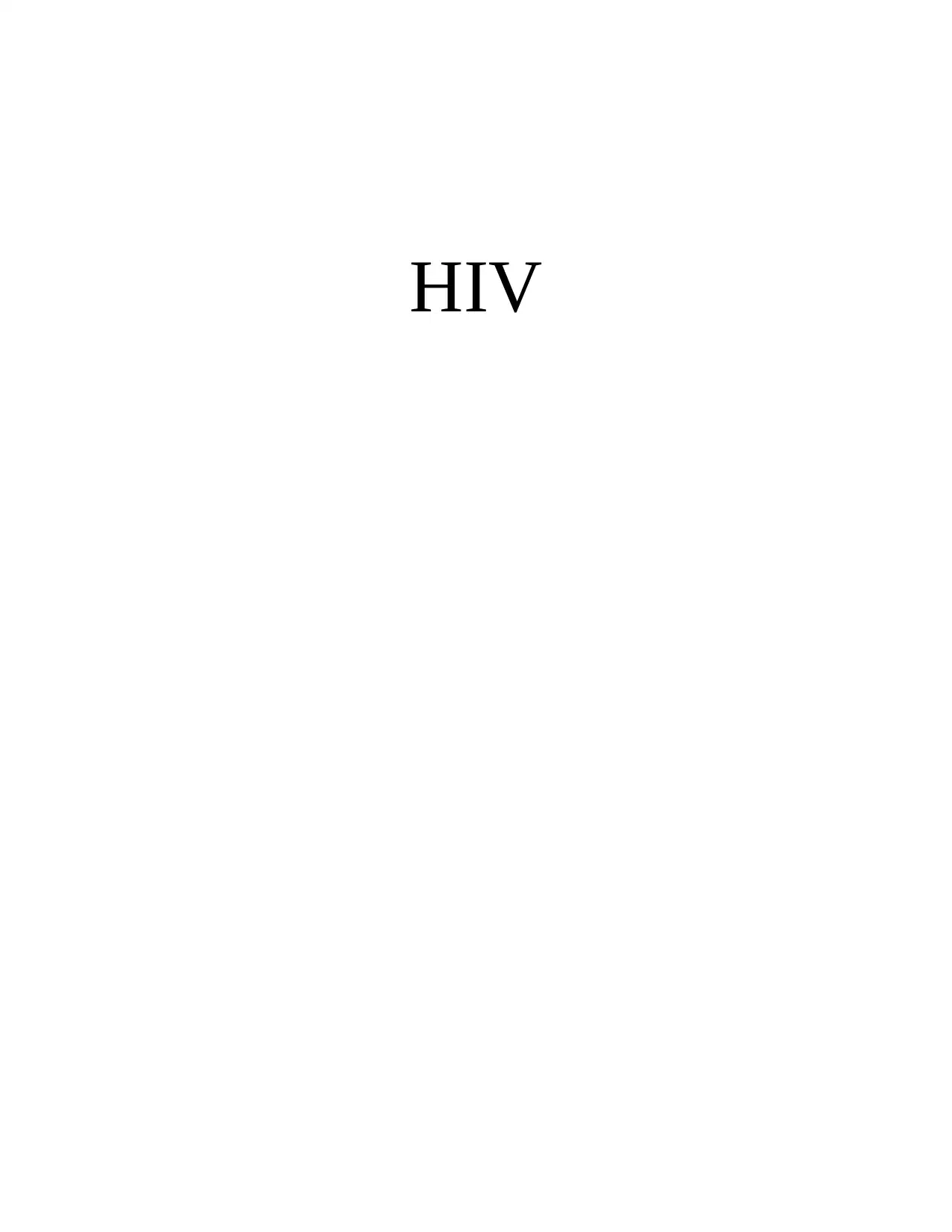
HIV
Paraphrase This Document
Need a fresh take? Get an instant paraphrase of this document with our AI Paraphraser
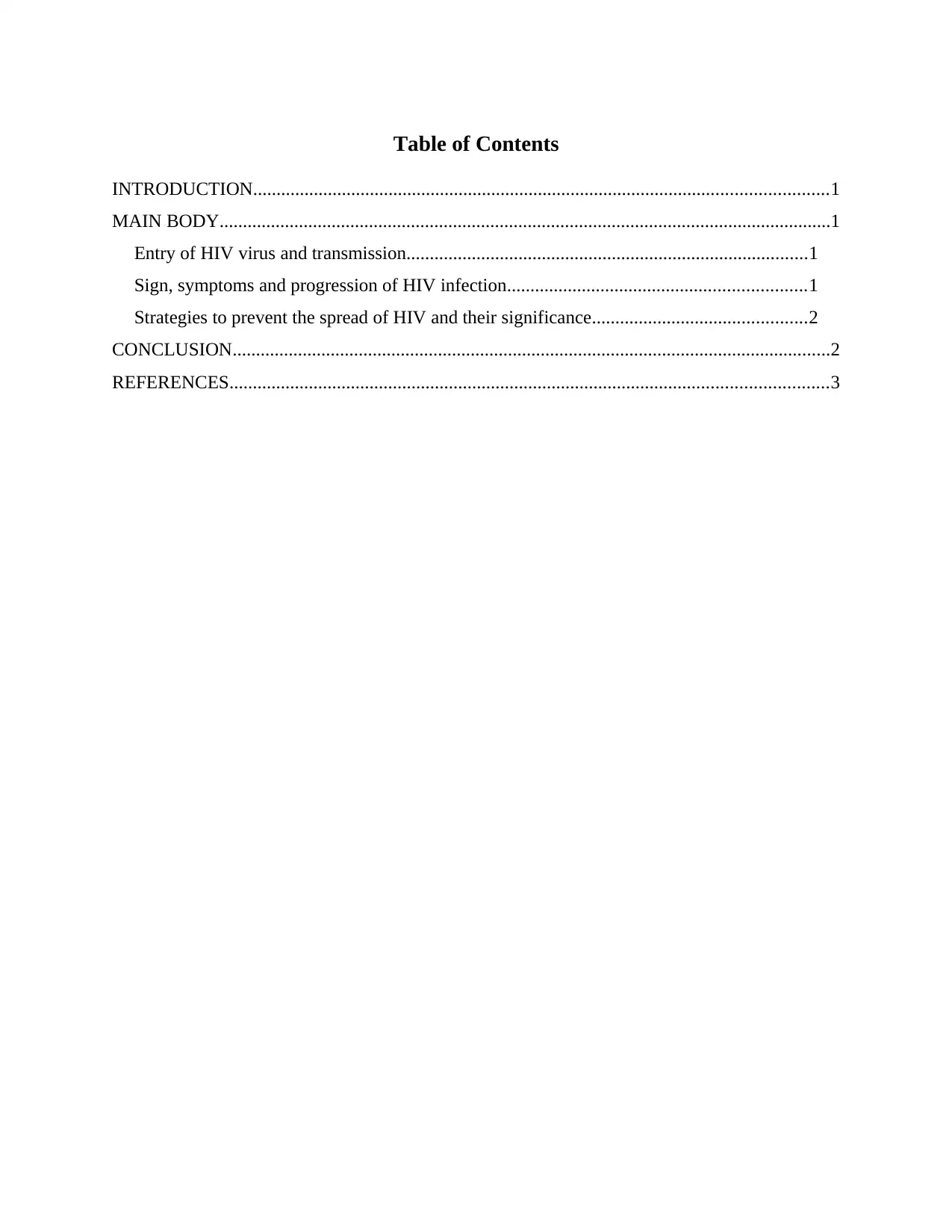
Table of Contents
INTRODUCTION...........................................................................................................................1
MAIN BODY...................................................................................................................................1
Entry of HIV virus and transmission......................................................................................1
Sign, symptoms and progression of HIV infection................................................................1
Strategies to prevent the spread of HIV and their significance..............................................2
CONCLUSION................................................................................................................................2
REFERENCES................................................................................................................................3
INTRODUCTION...........................................................................................................................1
MAIN BODY...................................................................................................................................1
Entry of HIV virus and transmission......................................................................................1
Sign, symptoms and progression of HIV infection................................................................1
Strategies to prevent the spread of HIV and their significance..............................................2
CONCLUSION................................................................................................................................2
REFERENCES................................................................................................................................3
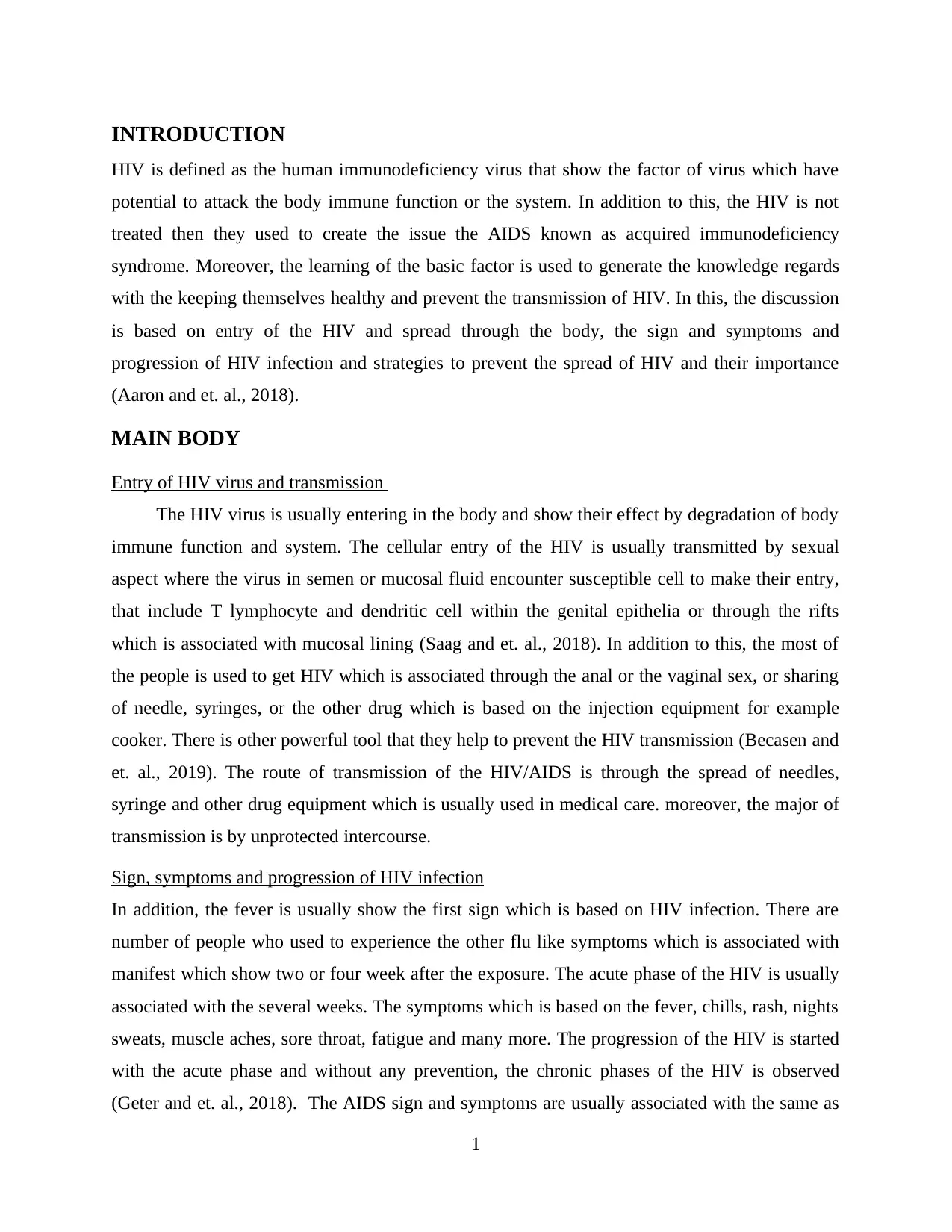
INTRODUCTION
HIV is defined as the human immunodeficiency virus that show the factor of virus which have
potential to attack the body immune function or the system. In addition to this, the HIV is not
treated then they used to create the issue the AIDS known as acquired immunodeficiency
syndrome. Moreover, the learning of the basic factor is used to generate the knowledge regards
with the keeping themselves healthy and prevent the transmission of HIV. In this, the discussion
is based on entry of the HIV and spread through the body, the sign and symptoms and
progression of HIV infection and strategies to prevent the spread of HIV and their importance
(Aaron and et. al., 2018).
MAIN BODY
Entry of HIV virus and transmission
The HIV virus is usually entering in the body and show their effect by degradation of body
immune function and system. The cellular entry of the HIV is usually transmitted by sexual
aspect where the virus in semen or mucosal fluid encounter susceptible cell to make their entry,
that include T lymphocyte and dendritic cell within the genital epithelia or through the rifts
which is associated with mucosal lining (Saag and et. al., 2018). In addition to this, the most of
the people is used to get HIV which is associated through the anal or the vaginal sex, or sharing
of needle, syringes, or the other drug which is based on the injection equipment for example
cooker. There is other powerful tool that they help to prevent the HIV transmission (Becasen and
et. al., 2019). The route of transmission of the HIV/AIDS is through the spread of needles,
syringe and other drug equipment which is usually used in medical care. moreover, the major of
transmission is by unprotected intercourse.
Sign, symptoms and progression of HIV infection
In addition, the fever is usually show the first sign which is based on HIV infection. There are
number of people who used to experience the other flu like symptoms which is associated with
manifest which show two or four week after the exposure. The acute phase of the HIV is usually
associated with the several weeks. The symptoms which is based on the fever, chills, rash, nights
sweats, muscle aches, sore throat, fatigue and many more. The progression of the HIV is started
with the acute phase and without any prevention, the chronic phases of the HIV is observed
(Geter and et. al., 2018). The AIDS sign and symptoms are usually associated with the same as
1
HIV is defined as the human immunodeficiency virus that show the factor of virus which have
potential to attack the body immune function or the system. In addition to this, the HIV is not
treated then they used to create the issue the AIDS known as acquired immunodeficiency
syndrome. Moreover, the learning of the basic factor is used to generate the knowledge regards
with the keeping themselves healthy and prevent the transmission of HIV. In this, the discussion
is based on entry of the HIV and spread through the body, the sign and symptoms and
progression of HIV infection and strategies to prevent the spread of HIV and their importance
(Aaron and et. al., 2018).
MAIN BODY
Entry of HIV virus and transmission
The HIV virus is usually entering in the body and show their effect by degradation of body
immune function and system. The cellular entry of the HIV is usually transmitted by sexual
aspect where the virus in semen or mucosal fluid encounter susceptible cell to make their entry,
that include T lymphocyte and dendritic cell within the genital epithelia or through the rifts
which is associated with mucosal lining (Saag and et. al., 2018). In addition to this, the most of
the people is used to get HIV which is associated through the anal or the vaginal sex, or sharing
of needle, syringes, or the other drug which is based on the injection equipment for example
cooker. There is other powerful tool that they help to prevent the HIV transmission (Becasen and
et. al., 2019). The route of transmission of the HIV/AIDS is through the spread of needles,
syringe and other drug equipment which is usually used in medical care. moreover, the major of
transmission is by unprotected intercourse.
Sign, symptoms and progression of HIV infection
In addition, the fever is usually show the first sign which is based on HIV infection. There are
number of people who used to experience the other flu like symptoms which is associated with
manifest which show two or four week after the exposure. The acute phase of the HIV is usually
associated with the several weeks. The symptoms which is based on the fever, chills, rash, nights
sweats, muscle aches, sore throat, fatigue and many more. The progression of the HIV is started
with the acute phase and without any prevention, the chronic phases of the HIV is observed
(Geter and et. al., 2018). The AIDS sign and symptoms are usually associated with the same as
1
⊘ This is a preview!⊘
Do you want full access?
Subscribe today to unlock all pages.

Trusted by 1+ million students worldwide
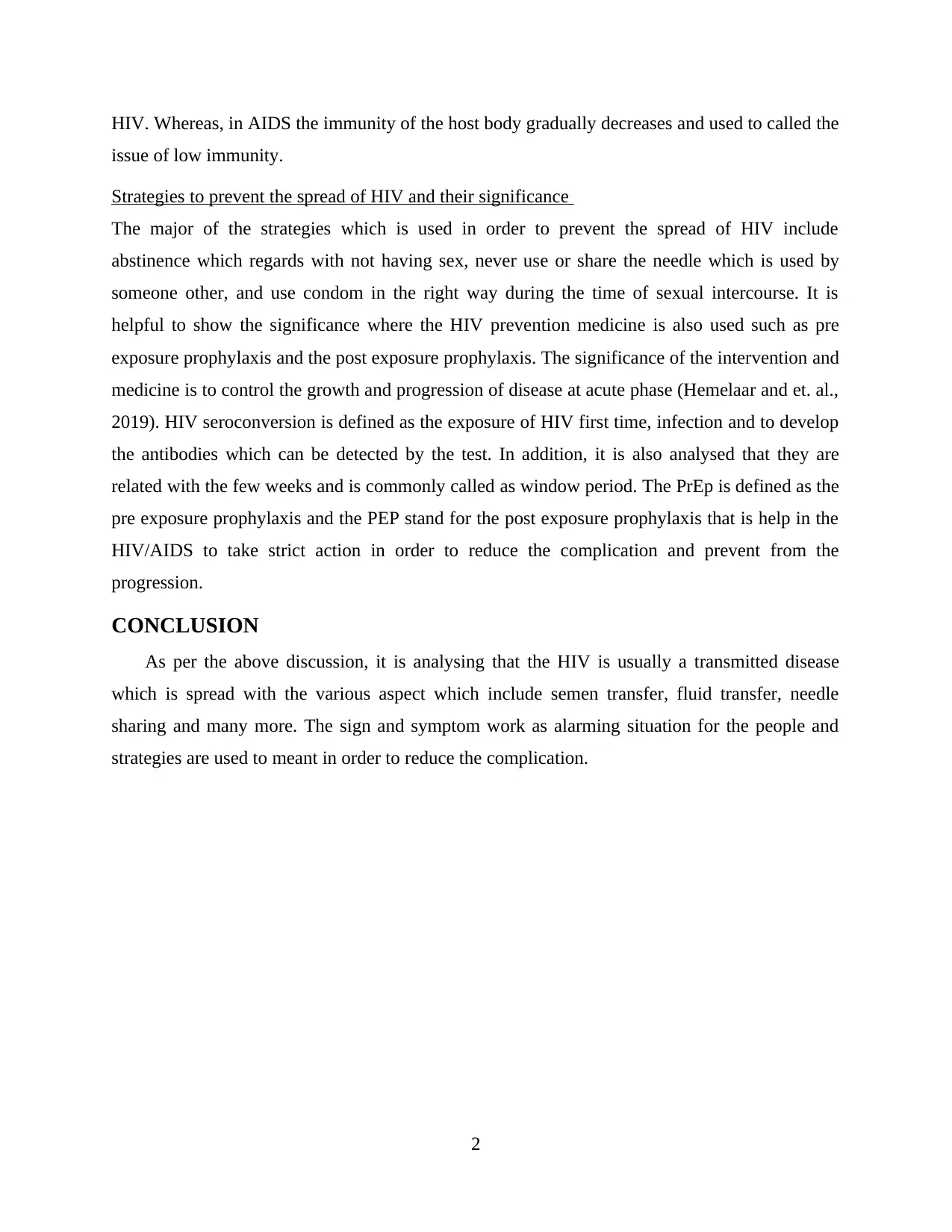
HIV. Whereas, in AIDS the immunity of the host body gradually decreases and used to called the
issue of low immunity.
Strategies to prevent the spread of HIV and their significance
The major of the strategies which is used in order to prevent the spread of HIV include
abstinence which regards with not having sex, never use or share the needle which is used by
someone other, and use condom in the right way during the time of sexual intercourse. It is
helpful to show the significance where the HIV prevention medicine is also used such as pre
exposure prophylaxis and the post exposure prophylaxis. The significance of the intervention and
medicine is to control the growth and progression of disease at acute phase (Hemelaar and et. al.,
2019). HIV seroconversion is defined as the exposure of HIV first time, infection and to develop
the antibodies which can be detected by the test. In addition, it is also analysed that they are
related with the few weeks and is commonly called as window period. The PrEp is defined as the
pre exposure prophylaxis and the PEP stand for the post exposure prophylaxis that is help in the
HIV/AIDS to take strict action in order to reduce the complication and prevent from the
progression.
CONCLUSION
As per the above discussion, it is analysing that the HIV is usually a transmitted disease
which is spread with the various aspect which include semen transfer, fluid transfer, needle
sharing and many more. The sign and symptom work as alarming situation for the people and
strategies are used to meant in order to reduce the complication.
2
issue of low immunity.
Strategies to prevent the spread of HIV and their significance
The major of the strategies which is used in order to prevent the spread of HIV include
abstinence which regards with not having sex, never use or share the needle which is used by
someone other, and use condom in the right way during the time of sexual intercourse. It is
helpful to show the significance where the HIV prevention medicine is also used such as pre
exposure prophylaxis and the post exposure prophylaxis. The significance of the intervention and
medicine is to control the growth and progression of disease at acute phase (Hemelaar and et. al.,
2019). HIV seroconversion is defined as the exposure of HIV first time, infection and to develop
the antibodies which can be detected by the test. In addition, it is also analysed that they are
related with the few weeks and is commonly called as window period. The PrEp is defined as the
pre exposure prophylaxis and the PEP stand for the post exposure prophylaxis that is help in the
HIV/AIDS to take strict action in order to reduce the complication and prevent from the
progression.
CONCLUSION
As per the above discussion, it is analysing that the HIV is usually a transmitted disease
which is spread with the various aspect which include semen transfer, fluid transfer, needle
sharing and many more. The sign and symptom work as alarming situation for the people and
strategies are used to meant in order to reduce the complication.
2
Paraphrase This Document
Need a fresh take? Get an instant paraphrase of this document with our AI Paraphraser
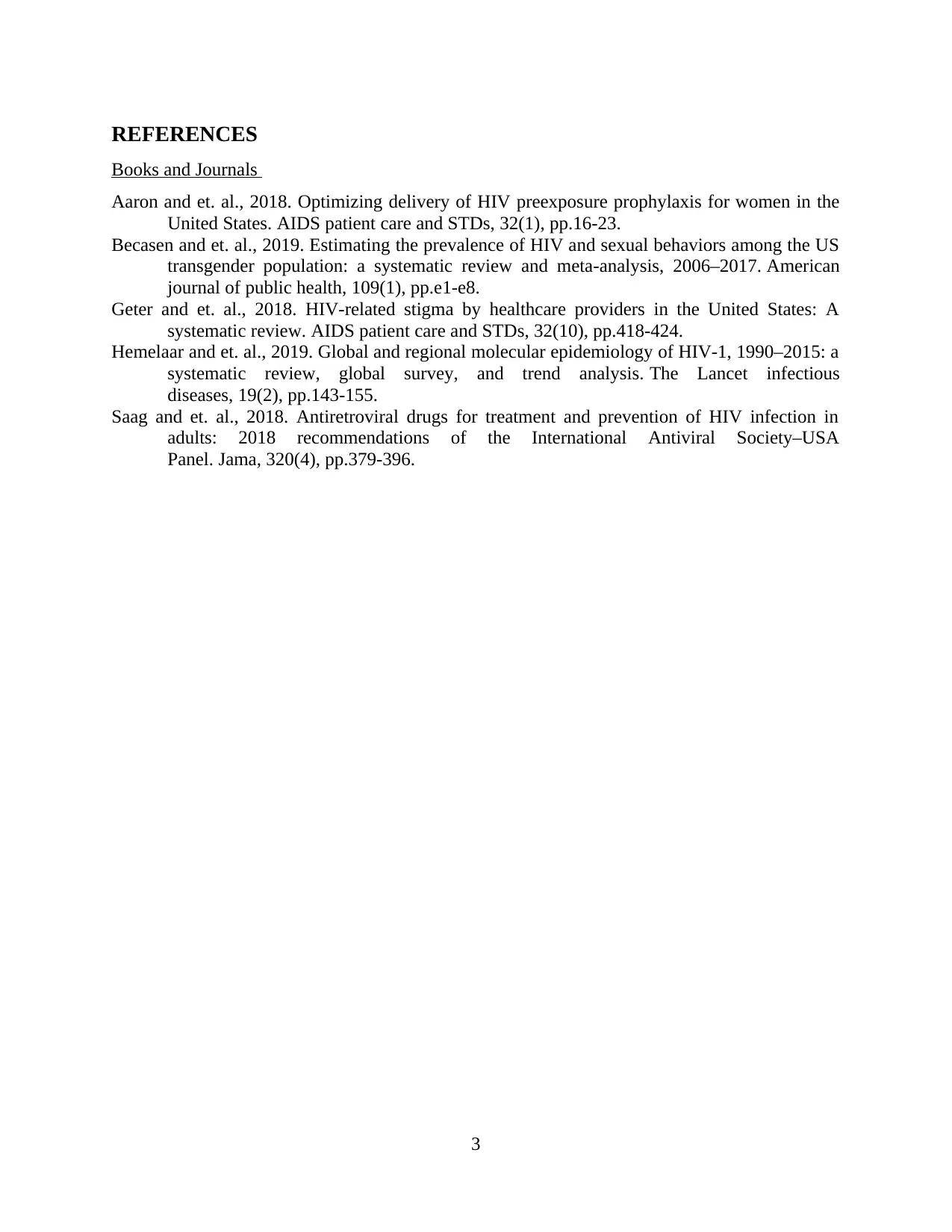
REFERENCES
Books and Journals
Aaron and et. al., 2018. Optimizing delivery of HIV preexposure prophylaxis for women in the
United States. AIDS patient care and STDs, 32(1), pp.16-23.
Becasen and et. al., 2019. Estimating the prevalence of HIV and sexual behaviors among the US
transgender population: a systematic review and meta-analysis, 2006–2017. American
journal of public health, 109(1), pp.e1-e8.
Geter and et. al., 2018. HIV-related stigma by healthcare providers in the United States: A
systematic review. AIDS patient care and STDs, 32(10), pp.418-424.
Hemelaar and et. al., 2019. Global and regional molecular epidemiology of HIV-1, 1990–2015: a
systematic review, global survey, and trend analysis. The Lancet infectious
diseases, 19(2), pp.143-155.
Saag and et. al., 2018. Antiretroviral drugs for treatment and prevention of HIV infection in
adults: 2018 recommendations of the International Antiviral Society–USA
Panel. Jama, 320(4), pp.379-396.
3
Books and Journals
Aaron and et. al., 2018. Optimizing delivery of HIV preexposure prophylaxis for women in the
United States. AIDS patient care and STDs, 32(1), pp.16-23.
Becasen and et. al., 2019. Estimating the prevalence of HIV and sexual behaviors among the US
transgender population: a systematic review and meta-analysis, 2006–2017. American
journal of public health, 109(1), pp.e1-e8.
Geter and et. al., 2018. HIV-related stigma by healthcare providers in the United States: A
systematic review. AIDS patient care and STDs, 32(10), pp.418-424.
Hemelaar and et. al., 2019. Global and regional molecular epidemiology of HIV-1, 1990–2015: a
systematic review, global survey, and trend analysis. The Lancet infectious
diseases, 19(2), pp.143-155.
Saag and et. al., 2018. Antiretroviral drugs for treatment and prevention of HIV infection in
adults: 2018 recommendations of the International Antiviral Society–USA
Panel. Jama, 320(4), pp.379-396.
3
1 out of 5
Related Documents
Your All-in-One AI-Powered Toolkit for Academic Success.
+13062052269
info@desklib.com
Available 24*7 on WhatsApp / Email
![[object Object]](/_next/static/media/star-bottom.7253800d.svg)
Unlock your academic potential
Copyright © 2020–2025 A2Z Services. All Rights Reserved. Developed and managed by ZUCOL.





